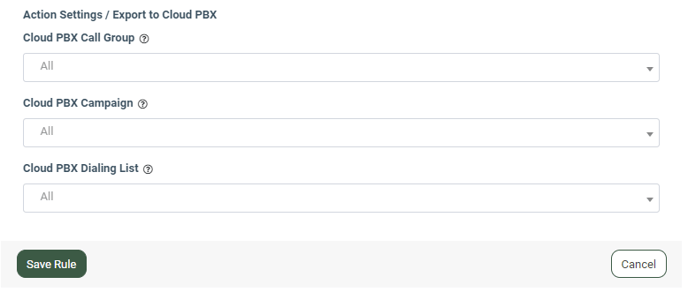The Export to Cloud PBX tracking type allows you to add the lead details to the selected dialing list in the Cloud PBX component when the selected trigger event takes place.
The Export to Cloud PBX tracking type allows you to export a lead along with all its data to the Dialing list requests on Cloud PBX, depending on the processing of certain events in your system so that the operator has the opportunity to contact these leads.
Read more about the Event Tracking feature and its configuration in the “Event Tracking (LMS / Call Logic)” Knowledge Base article.
This rule can be configured on Product, Campaign, and Publisher levels.
Read more about Tracking Rule setting up on the Product level in this Knowledge Base article.
Read more about Tracking Rule setting up on the Campaign level in this Knowledge Base article.
Read more about Tracking Rule setting up on the Publisher level in this Knowledge Base article.
To create this tracking rule, fill in the following fields in the “Add Rule” pop-up window:
- Trigger: Select the event that triggers the action:
- [LMS] Lead Sold: The lead is sold through the Campaign.
- [LMS] Post Reject: The post was rejected (for Ping-Post products only).
- [LMS] Campaign Rejected: The Campaign has rejected the lead.
- [LMS] Campaign Sold: The lead was sold to the Сampaign.
- [LMS] Lead Offer Received: The lead status changed to "Offer Received" after a successful ping (for Ping Post Products only).
- [Call Logic] Lead Sold: Lead has received 'Publisher sold' status.
- [Call Logic] Lead Rejected: Lead has received "Publisher rejected" status.
- [Call Logic] Campaign Rejected: Buyer rejected lead.
- [Call Logic] Campaign Accepted: Buyer accepted the lead. No matter the final Buyer status of a lead.
- [Call Logic] Campaign Sold: Lead has received "Buyer sold" status.
- [Call Logic] Call Recorded: Call recorded and ready to download.
- [Call Logic] Publisher Earning Received: Fires every time the Publisher gets earning (Direct Sold / Revenue Post-back).
- [Call Logic] Buyer response: Fires every time data is sent to the Buyer.
- [Call Logic] Disposition Updated: Buyer Disposition has been updated.
- [Call Logic] Publisher Earning Adjusted: Lead Adjustment happens.
- [Call Logic] Lead Return: Lead Return happens.
- [Call Logic] Lead Partial Return: Lead Partial Return happens.
- [Call Logic] Duration To Sell Reached: Lead has reached the "Duration to sell" time.
- [Call Logic] AMD: Answering machine detected on the buyer's side.
- [Call Logic] Revenue Postback: Revenue Postback sent.
- Action: Select the “[PBX] Export to Cloud PBX” option.
Once you select the preferable event, click the “Next” button to proceed with the setup.
The “Add Rule” window allows you to set up additional filters for the selected event. The list of available filters may vary based on the user role, platform, and configuration level. The filter fields are optional. If no filters are set up, the action will be triggered for all the leads that fit the event trigger.
Depending on the user role, platform, and configuration level, the following filters for trigger settings are available:
- Method: Select the Method (POST/FORM).
- Publisher: Select the Publisher.
- Publisher Exclude: Select the Publisher to exclude from the rule.
- Channel: Select the Channel.
- Channel Exclude: Select the Publisher Channel to exclude from the rule.
- Call Tracking Pool: Select the call tracking pool (available only for Call Logic triggers).
- Source: Select the Source.
- Source Exclude: Select the Source to exclude from the rule.
- Buyer: Select the Buyer.
- Campaign: Select the Campaign.
- Pingtree: Select the Pingtree.
- Price Restrictions: Select the Price restrictions (Price is greater than 0, Price is greater than a certain value, Price is greater than or equal to a certain value, Price is lower than a certain value, Price is lower than or equal to a certain value, Price range inclusive). Note: The “Price range inclusive” value is available only for the “Lead Sold” and “Campaign Sold” triggers.
- Price Restriction Value: Enter the price value.
- Min Price: Enter the minimum price value to trigger the rule by the price range (available only for the “Price range inclusive” value in the “Price Restrictions” field).
- Max Price: Enter the maximum price value to trigger the rule by the price range (available only for the “Price range inclusive” value in the “Price Restrictions” field).
-1.png?width=688&height=967&name=unnamed%20(67)-1.png) The “Action Settings/Export to Cloud PBX” block allows you to configure the action required for the rule setup:
The “Action Settings/Export to Cloud PBX” block allows you to configure the action required for the rule setup:
- Cloud PBX Call Group: Select the Call Group (created in the Cloud PBX component).
- Cloud PBX Campaign: Select the Campaign (availability depends on the Call Group) (created in the Cloud PBX component).
- Cloud PBX Dialing List: Select the Dialing List to which the record will be added when the trigger event takes place (created in the Cloud PBX component).
Click the “Save Rule” button to confirm.

